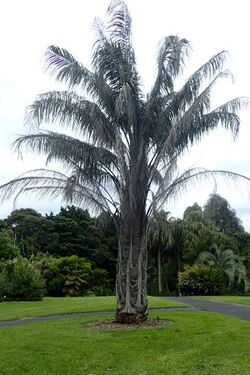Biology:Parajubaea torallyi
| Parajubaea torallyi | |
|---|---|

| |
| Scientific classification | |
| Kingdom: | Plantae |
| Clade: | Tracheophytes |
| Clade: | Angiosperms |
| Clade: | Monocots |
| Clade: | Commelinids |
| Order: | Arecales |
| Family: | Arecaceae |
| Genus: | Parajubaea |
| Species: | P. torallyi
|
| Binomial name | |
| Parajubaea torallyi (C.Mart.) Burret
| |
| Synonyms[2] | |
| |
Parajubaea torallyi, commonly known as the palma de Pasobaya or Bolivian mountain coconut, is a species of evergreen flowering plant of genus Parajubaea, in the family Arecaceae, closely related to the coconut palm in the tribe Cocoseae.
It is endemic to Bolivia, where it grows in dry forests on steep rocky slopes at 2,400–3,400 metres (7,900–11,200 ft) in altitude.[1]
It is cultivated for its stunning ornamental properties united to its cold hardiness.
In cultivation it prefers a mild or cool climate without extremes of temperature and a neutral to acidic soil, and it tolerates droughts but not excess of water.
It is now an endangered species, threatened by habitat loss.[3]
Description
Parajubaea torallyi can be over 13 meters in height. It can withstand temperatures of -13 degrees Celsius (9 degrees Fahrenheit). The fruits, or cocos, grow 5–10 cm in diameter in clusters weighing up to 15 kg.[4][5]
References
- ↑ 1.0 1.1 Moraes, M. (1998). "Parajubaea torallyi". IUCN Red List of Threatened Species 1998: e.T38626A10140174. doi:10.2305/IUCN.UK.1998.RLTS.T38626A10140174.en. https://www.iucnredlist.org/species/38626/10140174. Retrieved 15 November 2021.
- ↑ The Plant List
- ↑ Zipcode Zoo entry
- ↑ Burret, Karl Ewald. 1930. Notizblatt des Botanischen Gartens und Museums zu Berlin-Dahlem 11: 50, Parajubaea torallyi
- ↑ Martius, Carl Friedrich Philipp von. 1847. Voyage dans l'Amérique Méridionale v 7, part 3, page 105, pl. 15, f. 3. 1834, Diplothemium torallyi (1834 being the date of the voyage, 1847 the date of the publication of the books)
Wikidata ☰ Q3620498 entry
 |


